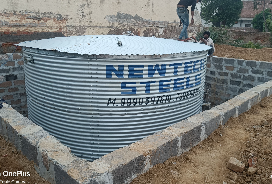Effluent Treatment Plants (ETP) and Sewage Treatment Plants (STP) play a pivotal role in managing and treating wastewater effectively. An integral component of these systems is the storage tanks, which require careful design to ensure optimal functionality and efficiency. In this blog post, we will explore the key considerations for designing ETP and STP storage tanks, shedding light on the crucial aspects that contribute to their effectiveness.
- Capacity Planning: Determining the appropriate storage capacity is the first step. A thorough analysis of the expected wastewater flow, peak volumes, and retention time is essential. This ensures that the storage tanks can handle variations in inflow and maintain efficient treatment processes.
- Material Selection: Choosing the right material for ETP and STP storage tanks is critical. Factors such as corrosion resistance, durability, and compatibility with the treated wastewater must be considered. Common materials include stainless steel, fiberglass, and high-density polyethylene (HDPE).
- Corrosion Protection: Given the corrosive nature of wastewater, incorporating effective corrosion protection measures is vital. This may involve selecting corrosion-resistant materials, applying protective coatings, or utilizing liners to enhance the longevity of the storage tanks.
- Accessibility and Maintenance: Easy accessibility for inspection and maintenance is crucial for sustainable operations. Design considerations should include features such as manholes, access platforms, and adequate spacing to facilitate routine checks, repairs, and cleaning.
- Safety Measures: Safety is paramount in the design of ETP and STP storage tanks. Implementing measures such as anti-slip surfaces, safety railings, and proper ventilation ensures a secure working environment for maintenance personnel.
- Compliance with Regulations: Adherence to local and international regulations is non-negotiable. Designing storage tanks that comply with environmental standards, safety codes, and wastewater treatment guidelines is essential to avoid legal complications and ensure responsible wastewater management.
- Integration with Treatment Processes: Seamless integration with the overall ETP or STP design is crucial. The storage tanks should complement the treatment processes, allowing for efficient inflow, equalization, and distribution of wastewater within the plant.
- Future Expansion: Anticipating future growth and expansion is a wise consideration. Designing storage tanks with scalability in mind allows for straightforward modifications or additions to accommodate increased wastewater treatment demands.
- Energy Efficiency: Implementing energy-efficient design features, such as optimizing tank dimensions for reduced pumping requirements and incorporating insulation to minimize heat loss, contributes to the overall sustainability of the ETP or STP.
- Environmental Impact: Minimizing the environmental footprint should be a priority. Designing storage tanks that facilitate proper sludge management, odor control, and efficient treatment processes helps in achieving environmentally responsible wastewater treatment.
Conclusion:
The design of ETP and STP storage tanks is a multifaceted process that demands careful consideration of various factors. By prioritizing capacity planning, material selection, safety, compliance, and sustainability, engineers and designers can create storage solutions that not only meet regulatory requirements but also contribute to efficient and responsible wastewater management.



